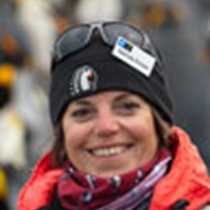The sound of the ship punching through brash ice woke us up early this morning. It was the strange and yet, appealing sound of a new and exciting adventure awaiting. On the bridge, however, the officers had other challenges besides the brash ice: a thick fog was limiting visibility in a sea dotted by tabular icebergs and bergy bits.
Weather conditions change pretty quickly in the Antarctic, and in this opportunity we took full advantage of it. A foggy and grey morning turned into a terrific sunny day at Brown Bluff, the place chosen for a landing on the Antarctic continent. The impressive towering cliffs provided a golden-brown background to our scenery of blue sea and white ice, as well as a reminder of the volcanic legacy of this region. The tall bluffs provide nesting sites for cape and snow petrels, which were seeing soaring gracefully above us. However, our attention was driven by the sight of Adèlie penguins queuing up in groups by the shoreline, heading out to sea in a single line of black and white. At times, their flow was continuous like droplets of water dripping off a leaky faucet. Suddenly, a penguin would change its mind and stop the motion and everyone would pile up behind it. Then, the group would assess and re-assess the situation at the beach, moving their heads looking side to side until, without any warning signal, another penguin leads the way out to sea and everyone follows. This same scene was repeated many times throughout our visit, as we enjoyed watching and wondering what had just happened.
Adèlie penguins breed successfully in this colony of over 20,000 breeding pairs. Most adults were guarding two chicks, some as old as two weeks and some of about four weeks old, all looking well fed and providing us with delightful experiences. The activity in this busy colony was mesmerizing: a fight between adult penguins will start from time to time, with chest bumping and slapping each other with their hard flippers until the trespasser moved away; we saw skuas patrolling over the colony and taking advantage of a chick that wondered too far from its parents’ watch; an incessant traffic of penguins heading to and from the ocean that stopped at least once to look at us and continued in their journey. We spent hours watching the chicks begging for food to their devoted parents, who in many cases seemed to have done a very good job at feeding frequently these mini pin bowl-like chicks.
A walk on the nearby glacier suited some of us seeking breathtaking views, and those cruising on Zodiacs were rewarded seeing a leopard seal resting on an ice floe. The apparent apathy of this top predator resting near a busy penguin colony shows that good timing is everything in these wild places. Leopard seals know when to patrol the shoreline in search for inexperienced penguins.
As the day continued to be sunny and relatively warm for Antarctic temperatures, lunch on the sundeck was the appropriate choice. Soon after, we were sailing away to explore the southern portion of the Antarctic Sound but katabatic winds blowing off the Antarctic continent prevented us from continuing our course. The wind gusts peaked up to 64 knots at times, the equivalent of over 70 miles or 115 km/h. As conditions changed rapidly, our experienced captain and crew took the ship to an eastern channel between Joinville and Dundee Is, finding better sailing conditions to explore as far south as 63⁰40’S in the Erebus and Terror Gulf. Brash ice turned into large pieces of pack ice, some of which had leopard and crabeater seals resting on these icy beds. The pack ice became thicker and multi-year pack ice had trapped fragments of old icebergs creating fascinating shapes and shadows. We were now entering the territory of the largest penguin species in the world, so all eyes were in the lookout for the majestic emperor. We were unlucky this time, but our efforts were rewarded by the exciting maneuvering of our ship pushing through heavy and growling ice. Mission accomplished, this feels like a true expedition!







